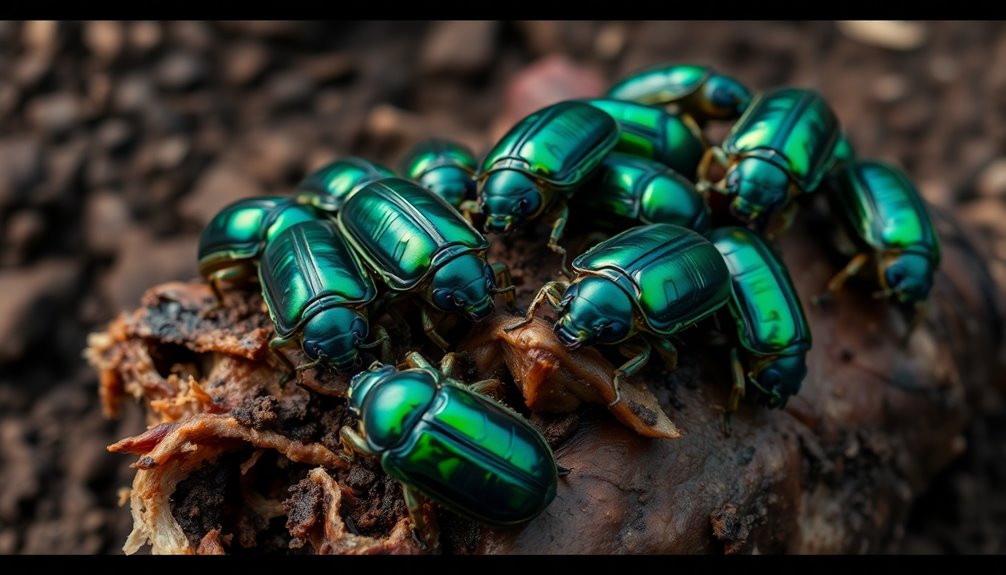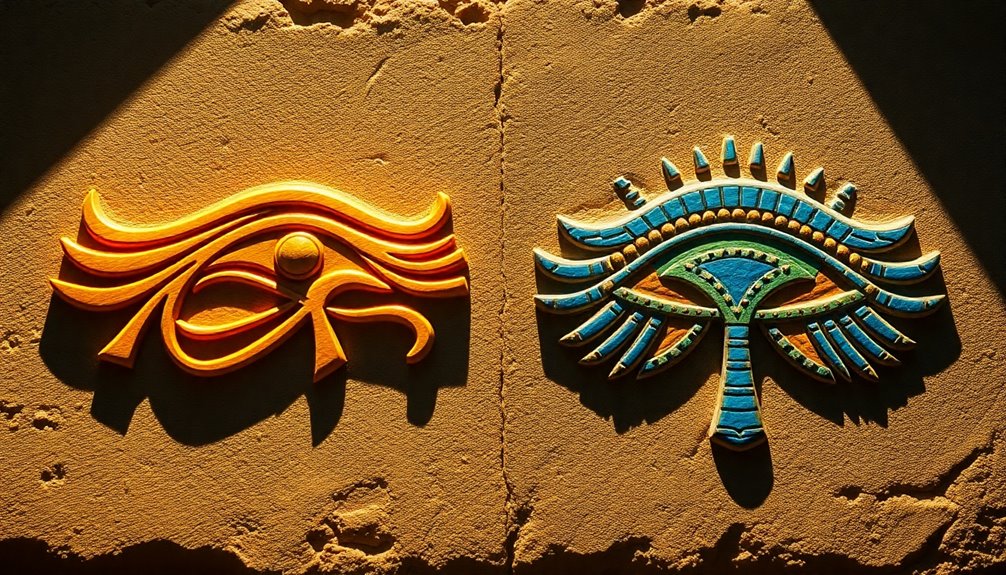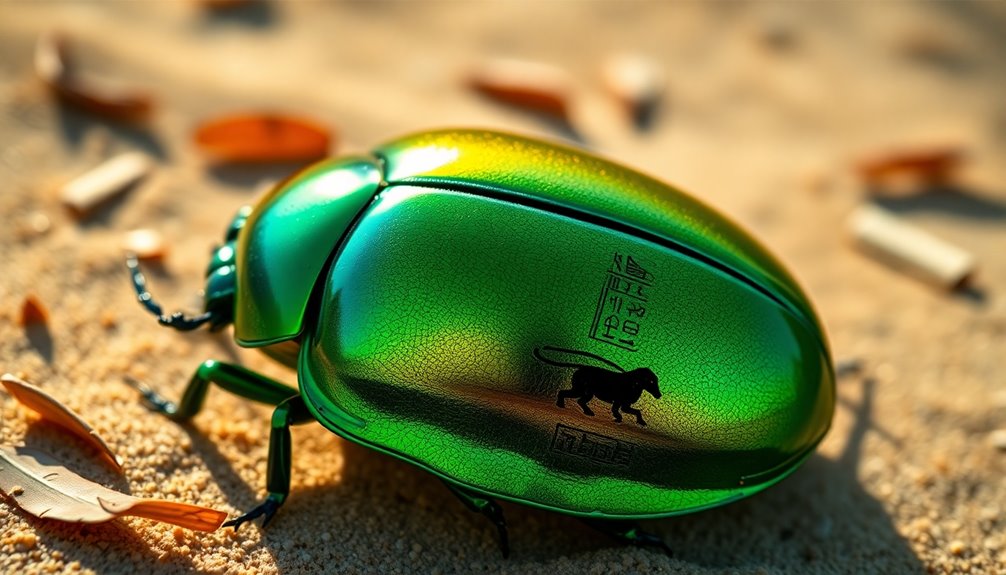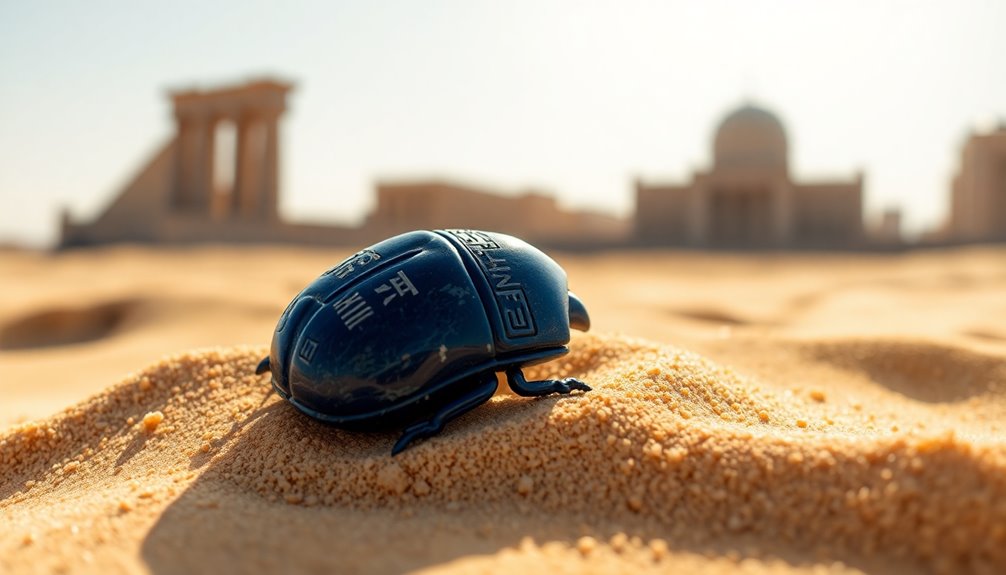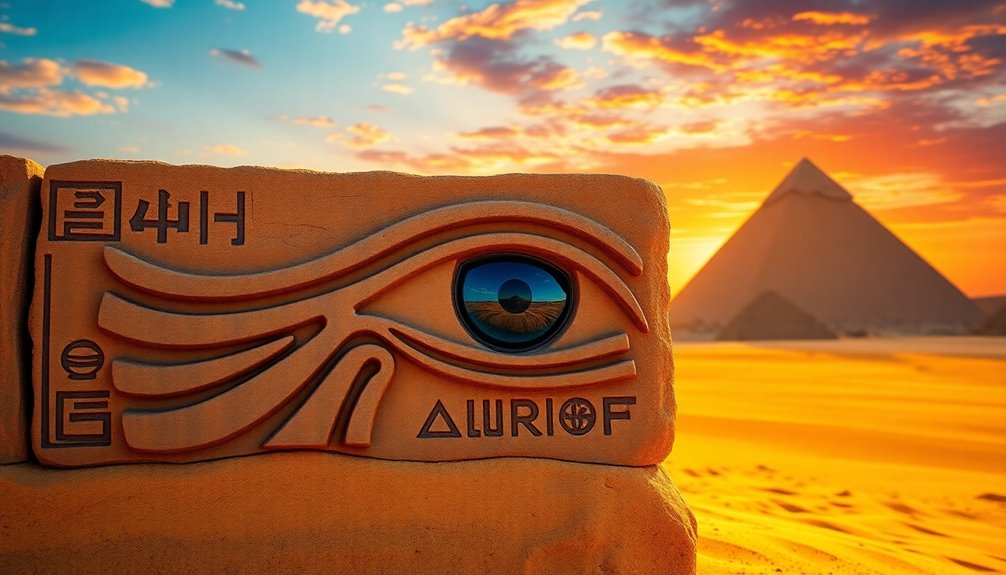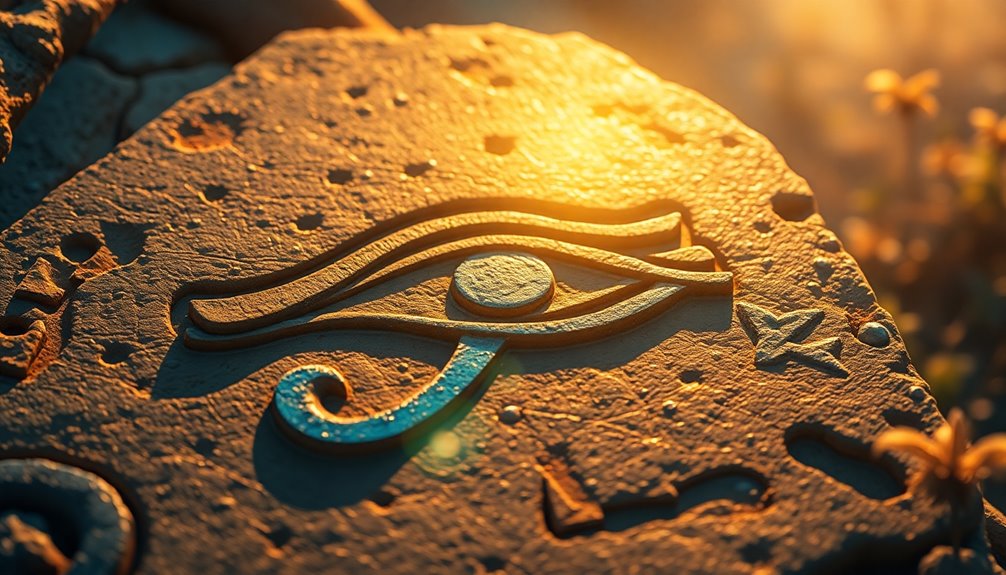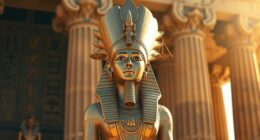No, scarabs don't eat flesh. These fascinating beetles primarily feed on decaying organic matter, like animal waste and plant material. They play a vital role in nutrient recycling in ecosystems, not the gruesome image often portrayed in films. The confusion often arises from dermestid beetles, which are the real flesh-eating beetles, known as nature's cleaners. While scarabs symbolize renewal and protection in various cultures, the portrayal of them as flesh-eating monsters is misleading. If you're curious about the differences between these beetles and their roles in nature, there's so much more to uncover.
Key Takeaways
- Scarabs primarily feed on decaying organic matter, such as animal waste, and do not consume flesh.
- There are over 30,000 species of scarabs, with many not engaging in any flesh-eating behavior.
- Misunderstandings arise from media portrayals, like "The Mummy," which inaccurately depict scarabs as flesh-eating monsters.
- Scarabs play a crucial role in nutrient recycling, contributing positively to ecosystem health through decomposition.
- Their cultural significance, especially in Ancient Egypt, emphasizes renewal and protection rather than aggression or harm.
Reality of Scarabs
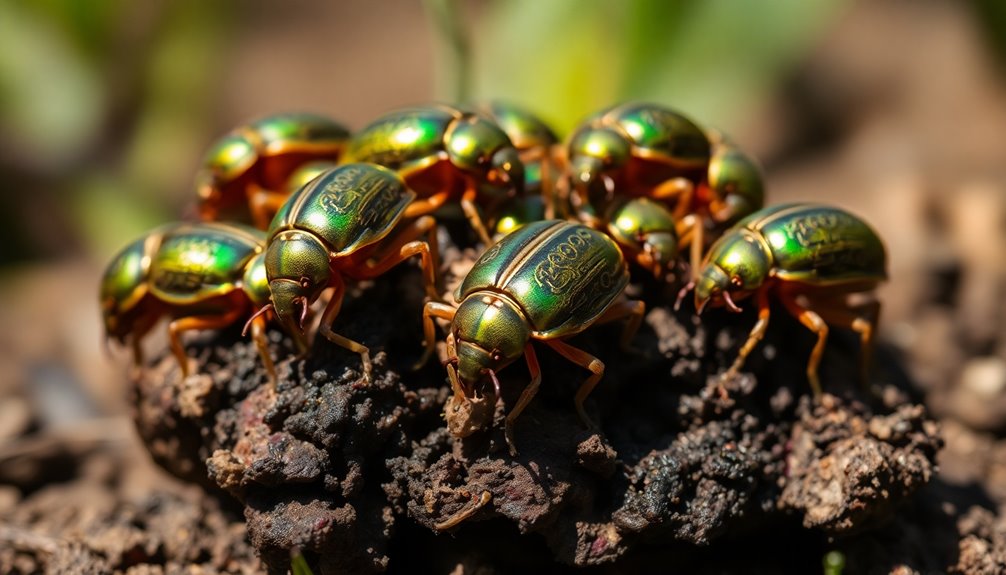
When you dig into the reality of scarabs, you'll find that these fascinating beetles are often misunderstood. Contrary to popular belief, scarabs, especially the sacred scarab (Scarabaeus sacer), don't consume flesh or behave like flesh-eating insects. While Hollywood might portray them as menacing creatures, the truth couldn't be further from that narrative.
With over 30,000 species of Scarabaeidae beetles worldwide, these insects have diverse diets and ecological roles. For instance, dung beetles—a prominent group within the scarab family—primarily feed on animal waste, playing a vital role in nutrient recycling. They even navigate using celestial bodies, showcasing their unique abilities.
It's essential to separate myth from fact. There's no evidence that supports the idea that scarabs strip flesh from living beings. Instead, they contribute considerably to ecosystems and have a rich history in culture and mythology, particularly in Ancient Egypt.
Understanding their true nature helps demystify these beneficial insects and highlights their importance beyond the sensationalism often seen in entertainment. So, next time you hear about scarabs, remember, they're not the flesh-eating monsters some make them out to be.
Dermestids: Nature's Cleaners
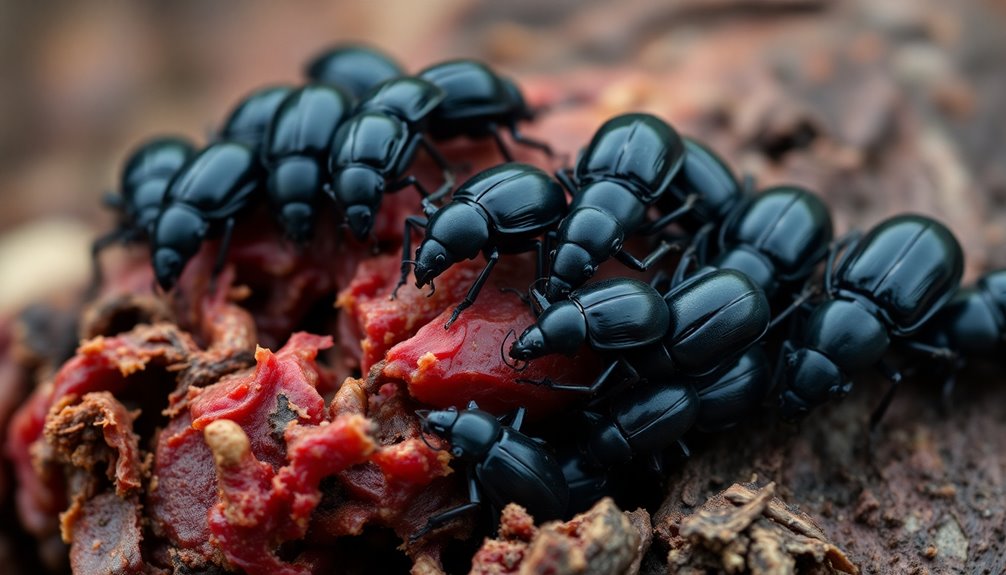
Dermestids, often referred to as nature's cleaners, play an essential role in the ecosystem by efficiently decomposing organic matter.
These Dermestid beetles, commonly known as carpet or skin beetles, thrive in environments where decomposing bodies are present. Their larvae are particularly adept at cleaning bones, capable of consuming dried organic materials and completely removing flesh within days.
If you've ever wondered how taxidermists prepare specimens, the answer often lies with these remarkable beetles. A colony of around 300 dermestids can clean a small skull in just three days, showcasing their incredible efficiency in decomposition.
They prefer temperatures between 65-85°F and are most active at night, making them effective decomposers in the dark.
With a complete life cycle lasting about two months, dermestids show rapid growth, with larvae developing in five to six weeks. This quick lifecycle allows them to thrive in various environments, continually contributing to the breakdown of organic matter.
Cultural Significance of Scarabs
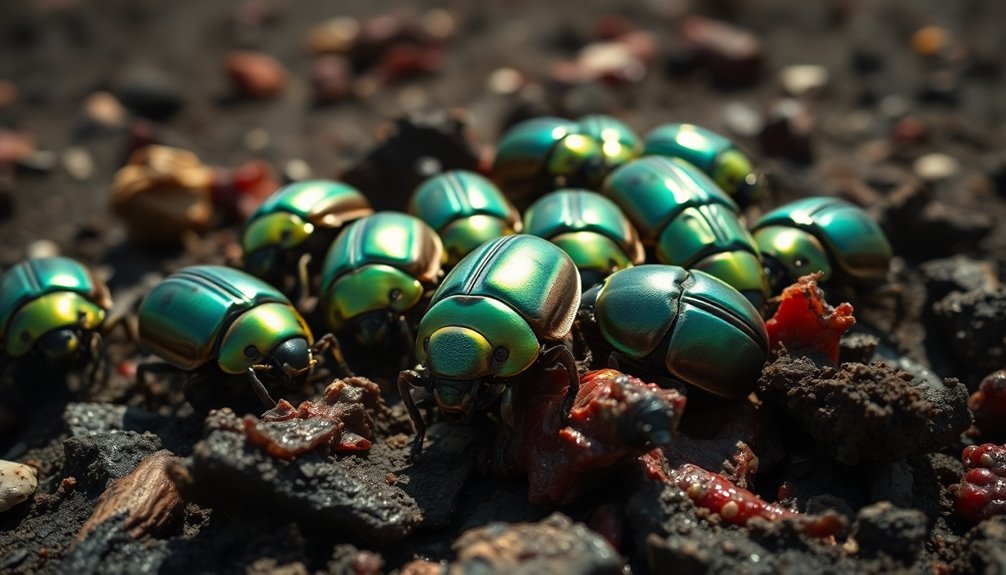
While dermestids play a vital role in decomposition, scarabs hold a prominent place in cultural history, especially in Ancient Egypt. The scarab beetle, particularly the Scarabaeus sacer, symbolizes renewal, protection, and the intricate cycle of life and death. In Ancient Egyptian culture, this beetle was often associated with the sun god Ra and the idea of resurrection, reflecting deep spiritual beliefs.
You'll find scarabs commonly depicted in various art forms and artifacts, from intricate jewelry to amulets and funerary items. These items weren't just decorative; they held significant power in ancient rituals, believed to protect the deceased in the afterlife.
The cultural significance of scarabs permeates Ancient Egyptian society, influencing art, mythology, and even daily life.
Despite their fascinating history, popular media, like The Mummy, has led to misconceptions about these creatures. Such portrayals can distort the public's understanding of scarabs, blending fact and fiction.
Recognizing the true cultural significance of scarabs enriches your appreciation for Ancient Egyptian practices and beliefs, grounding them in reality rather than myth.
Scientific Uses of Dermestids
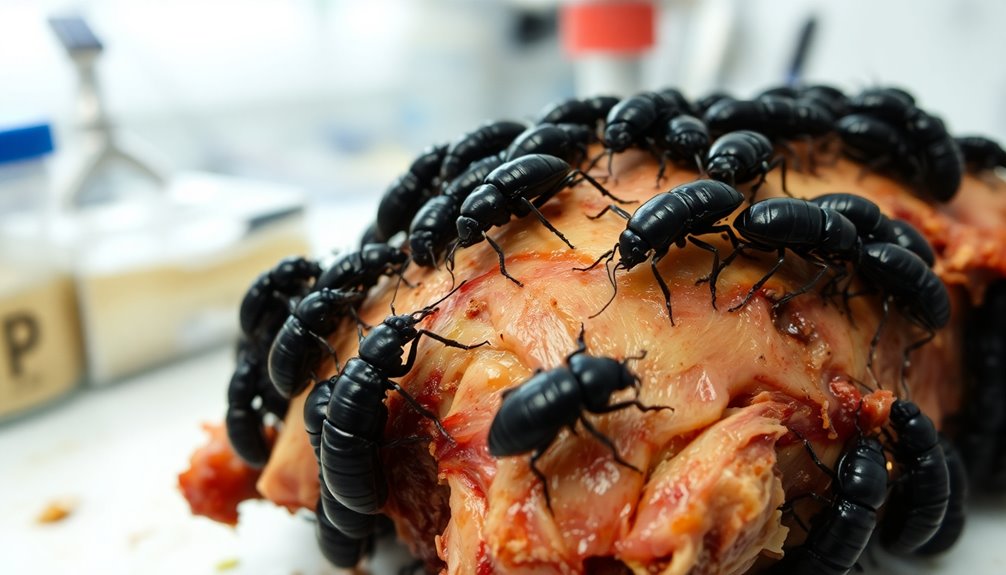
The remarkable role of dermestid beetles in scientific research highlights their importance in various fields, particularly forensic science and museum preservation.
These beetles, especially Dermestes maculatus, are invaluable for estimating the post-mortem interval (PMI) and providing insights into decomposition stages.
Here are a few ways dermestids are utilized:
- Forensic Science: Dermestids show how the decomposition process unfolds, helping experts determine the time of death.
- Museum Preservation: They clean bones efficiently without damaging them, making them essential for specimen preparation.
- Entomotoxicology: By detecting toxins in decomposed bodies, dermestids aid forensic scientists in criminal investigations.
With ideal conditions of around 30°C (86°F), dermestids can clean a small skull in just two to three days, showcasing their efficiency.
Their ability to assist in both forensic investigations and museum preservation underscores their significance.
Whether you're studying crime scenes or preserving historical artifacts, these beetles play a vital role in revealing hidden truths about life and death.
Media Misrepresentations of Scarabs
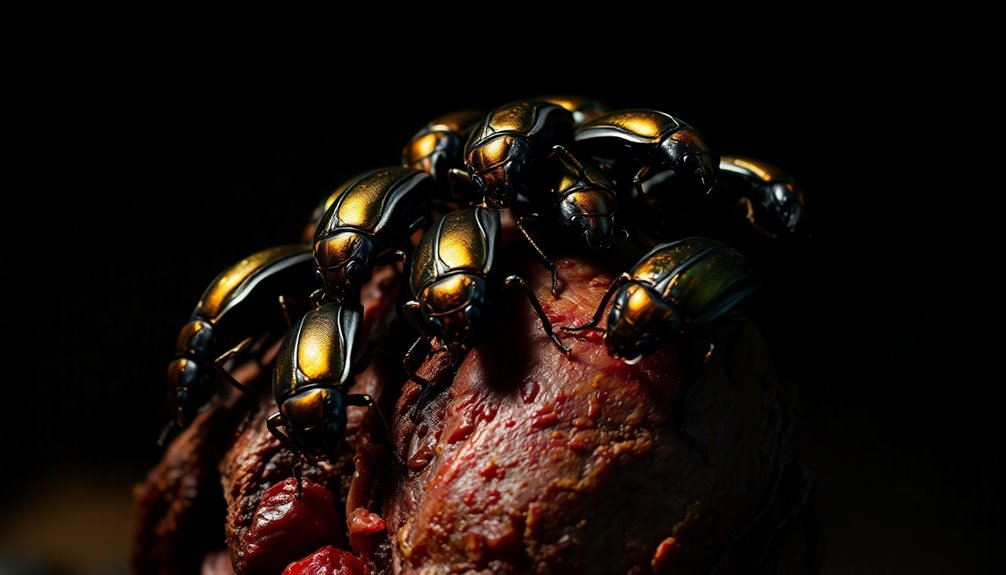
You might be surprised to learn how popular media distorts the truth about scarabs.
Films like "The Mummy" turn these beetles into terrifying, flesh-eating monsters, overshadowing their true significance in ancient Egyptian culture.
This blend of fiction and reality not only creates misconceptions but also fuels unnecessary fears about these essential scavengers.
Fiction vs. Reality
Scarab beetles often get a bad rap in popular media, where they're depicted as terrifying flesh-eaters, particularly in films like "The Mummy." This portrayal creates a dramatic narrative that strays far from the reality of these fascinating insects.
In truth, there are over 30,000 species of scarabs, and none are known to strip flesh from living beings.
Here are three common misconceptions about scarabs:
- Flesh-eating behavior: Scarabs don't consume flesh; they primarily feed on decaying organic matter, like dung.
- Cultural significance: The sacred scarab, Scarabaeus sacer, symbolizes renewal and protection in Ancient Egypt, not horror.
- Impact of media: Misrepresentations in films blur the lines between entertainment and reality, fostering unnecessary fear of these beetles.
Understanding the true nature of scarabs is essential. Their positive roles in ecosystems and culture are overlooked due to widespread misconceptions.
Cultural Misunderstandings Impact
Media misrepresentations of scarabs have led to widespread cultural misunderstandings that overshadow their true nature. Movies like *The Mummy* exaggerate the behavior of these beetles, portraying them as flesh-eating creatures, which creates a distorted image in your mind. In reality, Scarabaeidae beetles, including the revered sacred scarab, are primarily associated with dung and waste. There's no evidence they consume living flesh, contradicting their fictional depictions.
These misconceptions perpetuated by films blur the line between entertainment and reality. When you think of scarabs as monstrous insects, you overlook their significant ecological roles and the rich historical significance they held in ancient Egyptian culture. Scarabs symbolized renewal and protection, representing a profound connection to life and death that modern media fails to convey.
Accurate depictions of scarabs in popular culture are essential. They can help combat your fears and misunderstandings about these insects, fostering a deeper appreciation for their ecological contributions rather than a misguided fear of them.
Identifying Flesh-Eating Beetles

Identifying flesh-eating beetles, commonly known as dermestids or carpet beetles, can be straightforward if you know what to look for.
These beetles, including the notorious Dermestes maculatus, vary in size and appearance. Here are some key characteristics to help you spot them:
- Size: They typically range from 1/4 to 1 inch (6-25 mm). The black carpet beetle measures around 2.8-5 mm, while the varied carpet beetle is 2-3 mm.
- Habitat: You'll often find dermestids in decomposing environments, where they thrive on organic materials like dried flesh and animal fibers.
- Lifecycle: They undergo a distinct lifecycle, starting with an egg stage lasting about four days, followed by a larval stage of five to six weeks, before maturing into adults.
Understanding these traits can help you identify flesh-eating beetles effectively.
Remember, these beetles eat decaying matter, playing a significant role in natural decomposition, particularly in taxidermy and forensic contexts.
Frequently Asked Questions
Do Scarabs Actually Eat Flesh?
No, scarabs don't eat flesh. They primarily feed on dung and decaying plant matter, playing an essential role in nutrient recycling in ecosystems.
You might've seen films that suggest otherwise, but those portrayals are misleading.
With over 30,000 species, like the Sacred Scarab, these creatures are important for breaking down waste rather than consuming living beings.
Who Gets Eaten by Scarabs in the Mummy?
In "The Mummy," scarabs swarm like a dark cloud, consuming everything in their path.
You'll see characters like the unfortunate Dr. Alan Chamberlain meet a gruesome fate as these fictional beetles attack, creating a chilling atmosphere.
The scene plays on your fears, making it seem like scarabs are relentless flesh-eaters.
However, remember that in reality, these creatures are harmless dung beetles, more concerned with recycling organic matter than hunting humans.
Are the Flesh-Eating Beetles From the Mummy Real?
The flesh-eating beetles from "The Mummy" aren't real.
In reality, scarabs, like the sacred scarab, don't consume flesh from living beings. Instead, it's dermestid beetles, often called carpet beetles, that feed on dried flesh, primarily after decay.
These insects play an essential role in breaking down organic material, but they don't actively hunt or strip flesh from live animals.
Are There Any Bugs That Eat Flesh?
Yes, there are bugs that eat flesh! Dermestid beetles, like carpet and hide beetles, are notorious for their flesh-consuming habits.
You might find them in places where organic material decomposes. These beetles' larvae thrive on dried flesh and can clean bones efficiently, making them valuable in taxidermy and forensic science.
Conclusion
In the grand tapestry of nature, scarabs are often miscast as villains, yet they play a crucial role in our ecosystem. Just as the ancient Egyptians revered them, recognizing their significance beyond mere flesh consumption, you should appreciate the beauty of their role as nature's cleaners. So next time you hear about scarabs, remember that they're not just creepy crawlers; they're indispensable players in the circle of life, ensuring decay gives way to new beginnings.

